CUTO5007: Analyzing Cultural Tourism in Plovdiv & ECOC 2019 Impact
VerifiedAdded on 2023/06/09
|19
|4349
|326
Report
AI Summary
This report provides an in-depth analysis of cultural tourism in Plovdiv, Bulgaria, examining various typologies, cultural products, and their links to the market. It utilizes McKercher and Du Cros's Cultural Tourism Market diagram to categorize tourists and assesses the impact of Plovdiv being named the European Capital of Culture in 2019, considering social, economic, and environmental factors. The report also evaluates Plovdiv's destination development using Doxey’s Irridex and discusses future trends and criteria for becoming a European Capital of Culture. The conclusion summarizes the key findings and implications for Plovdiv's cultural tourism sector.

Cultural Tourism
Paraphrase This Document
Need a fresh take? Get an instant paraphrase of this document with our AI Paraphraser
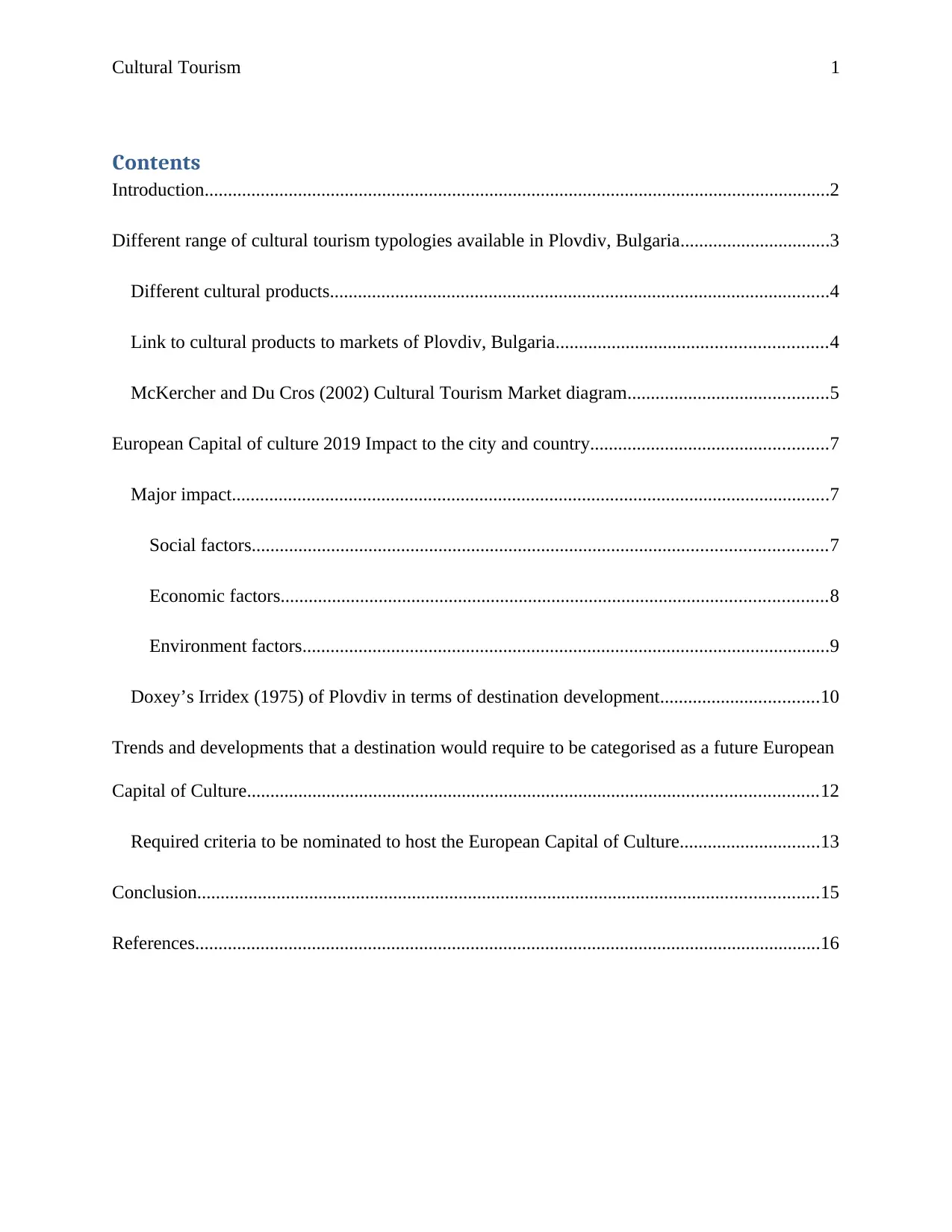
Cultural Tourism 1
Contents
Introduction......................................................................................................................................2
Different range of cultural tourism typologies available in Plovdiv, Bulgaria................................3
Different cultural products...........................................................................................................4
Link to cultural products to markets of Plovdiv, Bulgaria..........................................................4
McKercher and Du Cros (2002) Cultural Tourism Market diagram...........................................5
European Capital of culture 2019 Impact to the city and country...................................................7
Major impact................................................................................................................................7
Social factors...........................................................................................................................7
Economic factors.....................................................................................................................8
Environment factors.................................................................................................................9
Doxey’s Irridex (1975) of Plovdiv in terms of destination development..................................10
Trends and developments that a destination would require to be categorised as a future European
Capital of Culture..........................................................................................................................12
Required criteria to be nominated to host the European Capital of Culture..............................13
Conclusion.....................................................................................................................................15
References......................................................................................................................................16
Contents
Introduction......................................................................................................................................2
Different range of cultural tourism typologies available in Plovdiv, Bulgaria................................3
Different cultural products...........................................................................................................4
Link to cultural products to markets of Plovdiv, Bulgaria..........................................................4
McKercher and Du Cros (2002) Cultural Tourism Market diagram...........................................5
European Capital of culture 2019 Impact to the city and country...................................................7
Major impact................................................................................................................................7
Social factors...........................................................................................................................7
Economic factors.....................................................................................................................8
Environment factors.................................................................................................................9
Doxey’s Irridex (1975) of Plovdiv in terms of destination development..................................10
Trends and developments that a destination would require to be categorised as a future European
Capital of Culture..........................................................................................................................12
Required criteria to be nominated to host the European Capital of Culture..............................13
Conclusion.....................................................................................................................................15
References......................................................................................................................................16
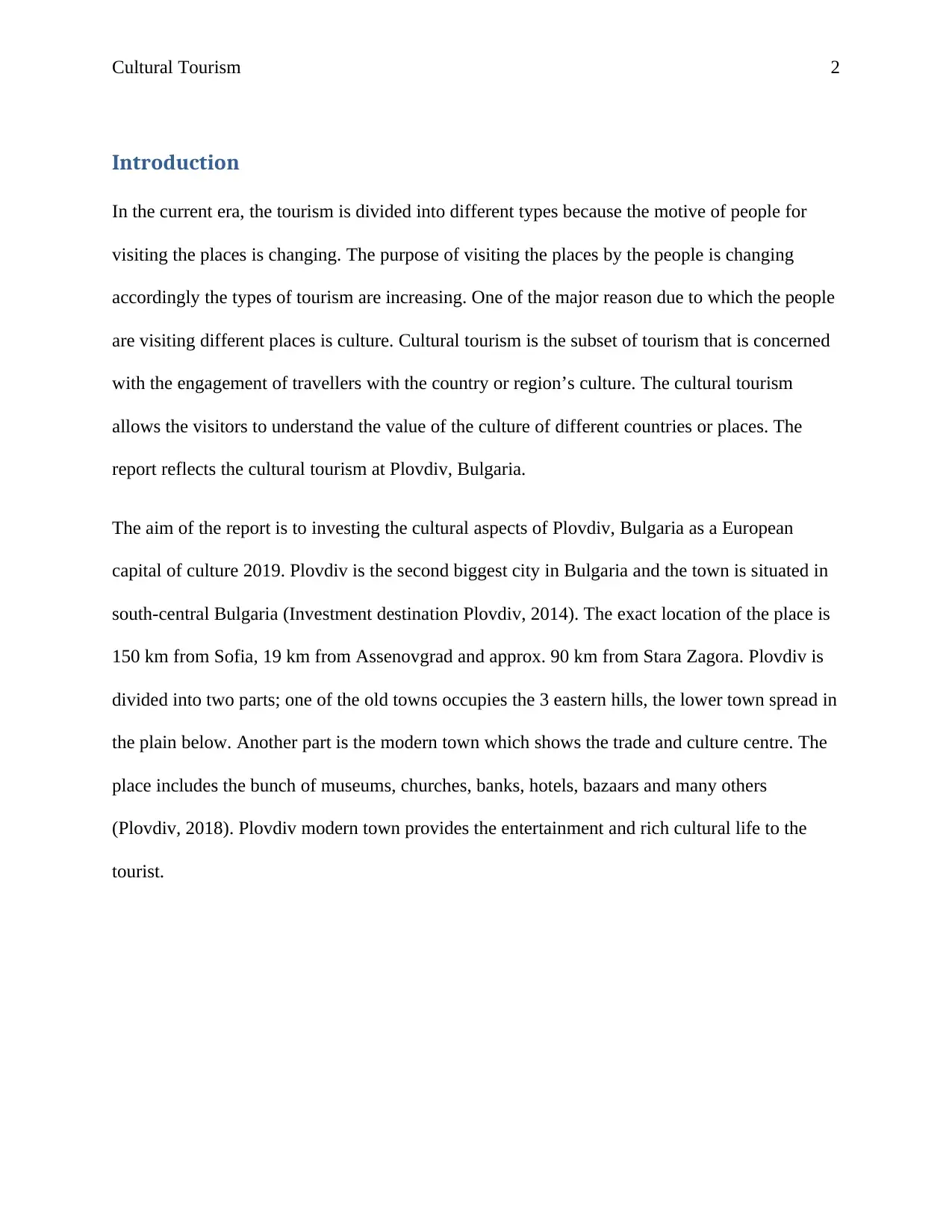
Cultural Tourism 2
Introduction
In the current era, the tourism is divided into different types because the motive of people for
visiting the places is changing. The purpose of visiting the places by the people is changing
accordingly the types of tourism are increasing. One of the major reason due to which the people
are visiting different places is culture. Cultural tourism is the subset of tourism that is concerned
with the engagement of travellers with the country or region’s culture. The cultural tourism
allows the visitors to understand the value of the culture of different countries or places. The
report reflects the cultural tourism at Plovdiv, Bulgaria.
The aim of the report is to investing the cultural aspects of Plovdiv, Bulgaria as a European
capital of culture 2019. Plovdiv is the second biggest city in Bulgaria and the town is situated in
south-central Bulgaria (Investment destination Plovdiv, 2014). The exact location of the place is
150 km from Sofia, 19 km from Assenovgrad and approx. 90 km from Stara Zagora. Plovdiv is
divided into two parts; one of the old towns occupies the 3 eastern hills, the lower town spread in
the plain below. Another part is the modern town which shows the trade and culture centre. The
place includes the bunch of museums, churches, banks, hotels, bazaars and many others
(Plovdiv, 2018). Plovdiv modern town provides the entertainment and rich cultural life to the
tourist.
Introduction
In the current era, the tourism is divided into different types because the motive of people for
visiting the places is changing. The purpose of visiting the places by the people is changing
accordingly the types of tourism are increasing. One of the major reason due to which the people
are visiting different places is culture. Cultural tourism is the subset of tourism that is concerned
with the engagement of travellers with the country or region’s culture. The cultural tourism
allows the visitors to understand the value of the culture of different countries or places. The
report reflects the cultural tourism at Plovdiv, Bulgaria.
The aim of the report is to investing the cultural aspects of Plovdiv, Bulgaria as a European
capital of culture 2019. Plovdiv is the second biggest city in Bulgaria and the town is situated in
south-central Bulgaria (Investment destination Plovdiv, 2014). The exact location of the place is
150 km from Sofia, 19 km from Assenovgrad and approx. 90 km from Stara Zagora. Plovdiv is
divided into two parts; one of the old towns occupies the 3 eastern hills, the lower town spread in
the plain below. Another part is the modern town which shows the trade and culture centre. The
place includes the bunch of museums, churches, banks, hotels, bazaars and many others
(Plovdiv, 2018). Plovdiv modern town provides the entertainment and rich cultural life to the
tourist.
⊘ This is a preview!⊘
Do you want full access?
Subscribe today to unlock all pages.

Trusted by 1+ million students worldwide

Cultural Tourism 3
Different range of cultural tourism typologies available in Plovdiv,
Bulgaria
The cultural tourism includes a different range of typologies that might vary according to the
destination. The typologies are the classification that is done according to the general type as it
may include archaeology, psychology or the social sciences. In other words, the cultural tourism
refers to as the genre of special interest tourism that is based on the psychological, emotional and
other elements. The classification of the cultural tourism is done on the basis of elements which
include mass and passive tourism. The cultural tourism at Plovdiv, Bulgaria is divided into the
segments of the classical attraction of the cultural tourism. These segments are: -
Built and material values: - In this typology, the buildings, material values of art forms
are included. In Plovdiv, there is the presence of the different museums that show the
history and culture of the country. Along with this, the place is colourful when talking
about the craft and art (Guide Bulgaria, 2018).
Cultural values that are connected to lifestyle: - This typology includes the lifestyle,
leisure, habits, gastronomy and other elements. The culture that is followed by the local
people is linked with the history. Most of the people in their leisure time visit the Knyaz
Aleksandar market which is considered as busiest spot (Plovdiv Guide, 2018).
Events and festivals: - This typology includes the festivals and events that take place in
the place. Plovdiv includes the winter festival of symphony music which is held in the
month of January of every year. Along with this, in the fair camp different international
exhibitions take place (Plovdiv Guide, 2018).
Different range of cultural tourism typologies available in Plovdiv,
Bulgaria
The cultural tourism includes a different range of typologies that might vary according to the
destination. The typologies are the classification that is done according to the general type as it
may include archaeology, psychology or the social sciences. In other words, the cultural tourism
refers to as the genre of special interest tourism that is based on the psychological, emotional and
other elements. The classification of the cultural tourism is done on the basis of elements which
include mass and passive tourism. The cultural tourism at Plovdiv, Bulgaria is divided into the
segments of the classical attraction of the cultural tourism. These segments are: -
Built and material values: - In this typology, the buildings, material values of art forms
are included. In Plovdiv, there is the presence of the different museums that show the
history and culture of the country. Along with this, the place is colourful when talking
about the craft and art (Guide Bulgaria, 2018).
Cultural values that are connected to lifestyle: - This typology includes the lifestyle,
leisure, habits, gastronomy and other elements. The culture that is followed by the local
people is linked with the history. Most of the people in their leisure time visit the Knyaz
Aleksandar market which is considered as busiest spot (Plovdiv Guide, 2018).
Events and festivals: - This typology includes the festivals and events that take place in
the place. Plovdiv includes the winter festival of symphony music which is held in the
month of January of every year. Along with this, in the fair camp different international
exhibitions take place (Plovdiv Guide, 2018).
Paraphrase This Document
Need a fresh take? Get an instant paraphrase of this document with our AI Paraphraser
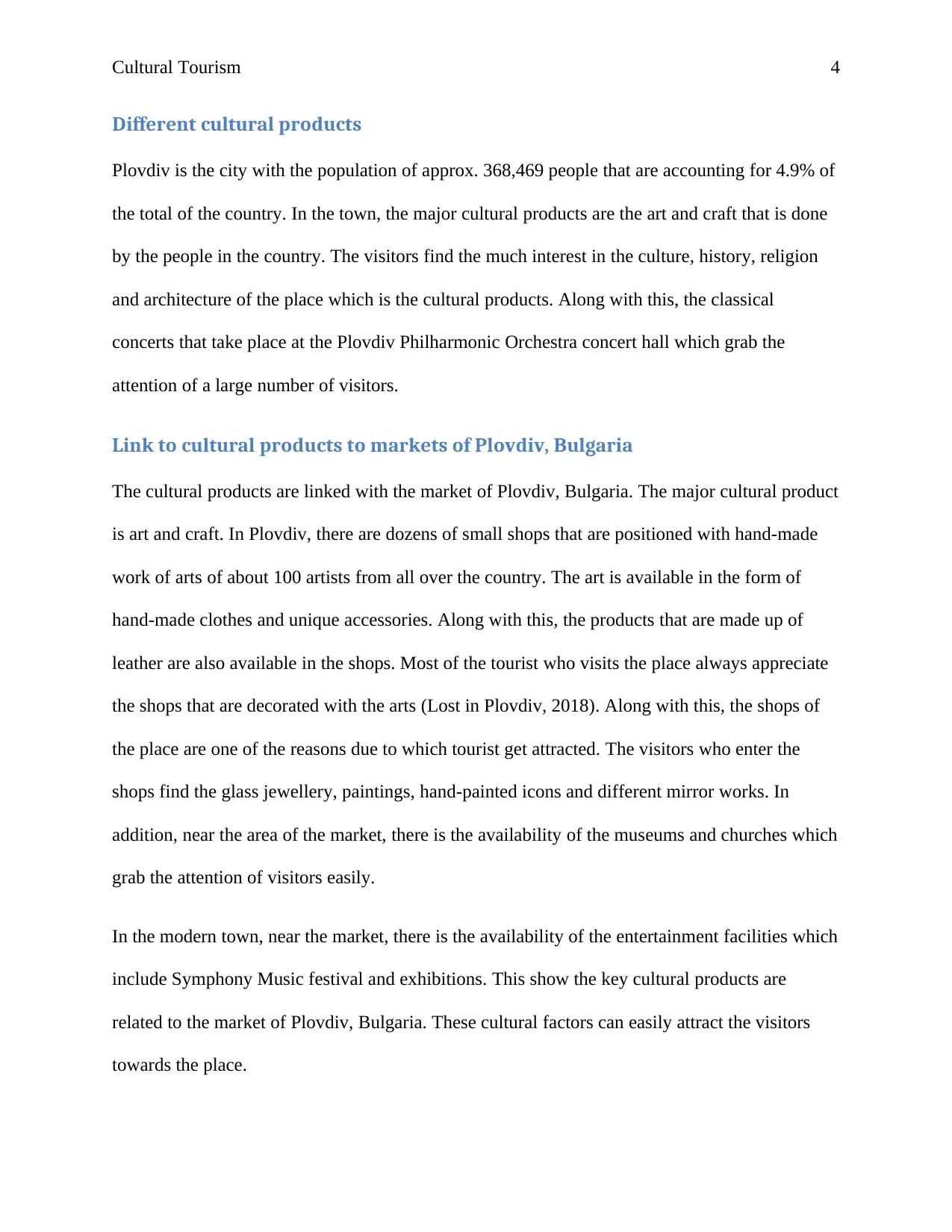
Cultural Tourism 4
Different cultural products
Plovdiv is the city with the population of approx. 368,469 people that are accounting for 4.9% of
the total of the country. In the town, the major cultural products are the art and craft that is done
by the people in the country. The visitors find the much interest in the culture, history, religion
and architecture of the place which is the cultural products. Along with this, the classical
concerts that take place at the Plovdiv Philharmonic Orchestra concert hall which grab the
attention of a large number of visitors.
Link to cultural products to markets of Plovdiv, Bulgaria
The cultural products are linked with the market of Plovdiv, Bulgaria. The major cultural product
is art and craft. In Plovdiv, there are dozens of small shops that are positioned with hand-made
work of arts of about 100 artists from all over the country. The art is available in the form of
hand-made clothes and unique accessories. Along with this, the products that are made up of
leather are also available in the shops. Most of the tourist who visits the place always appreciate
the shops that are decorated with the arts (Lost in Plovdiv, 2018). Along with this, the shops of
the place are one of the reasons due to which tourist get attracted. The visitors who enter the
shops find the glass jewellery, paintings, hand-painted icons and different mirror works. In
addition, near the area of the market, there is the availability of the museums and churches which
grab the attention of visitors easily.
In the modern town, near the market, there is the availability of the entertainment facilities which
include Symphony Music festival and exhibitions. This show the key cultural products are
related to the market of Plovdiv, Bulgaria. These cultural factors can easily attract the visitors
towards the place.
Different cultural products
Plovdiv is the city with the population of approx. 368,469 people that are accounting for 4.9% of
the total of the country. In the town, the major cultural products are the art and craft that is done
by the people in the country. The visitors find the much interest in the culture, history, religion
and architecture of the place which is the cultural products. Along with this, the classical
concerts that take place at the Plovdiv Philharmonic Orchestra concert hall which grab the
attention of a large number of visitors.
Link to cultural products to markets of Plovdiv, Bulgaria
The cultural products are linked with the market of Plovdiv, Bulgaria. The major cultural product
is art and craft. In Plovdiv, there are dozens of small shops that are positioned with hand-made
work of arts of about 100 artists from all over the country. The art is available in the form of
hand-made clothes and unique accessories. Along with this, the products that are made up of
leather are also available in the shops. Most of the tourist who visits the place always appreciate
the shops that are decorated with the arts (Lost in Plovdiv, 2018). Along with this, the shops of
the place are one of the reasons due to which tourist get attracted. The visitors who enter the
shops find the glass jewellery, paintings, hand-painted icons and different mirror works. In
addition, near the area of the market, there is the availability of the museums and churches which
grab the attention of visitors easily.
In the modern town, near the market, there is the availability of the entertainment facilities which
include Symphony Music festival and exhibitions. This show the key cultural products are
related to the market of Plovdiv, Bulgaria. These cultural factors can easily attract the visitors
towards the place.

Cultural Tourism 5
McKercher and Du Cros (2002) Cultural Tourism Market diagram
McKercher and Du Cros introduced the cultural tourism market diagram in which they provided
the details related to the different tourist types of the cultural tourism. The below given is the
cultural tourism Market diagram: -
The typology of cultural tourist by McKercher and Du Cros
(Source: Jovicic, 2016)
This diagram was formed with the motive to analyse the importance of cultural tourism in
making the decision to visit a destination. The diagram is based on the four major elements that
are low, high, deep and shallow (Jovicic, 2016). These elements are related to the experience
sought of the tourist.
The diagram shows that there are different tourist types of the cultural tourism which include: -
Serendipitous cultural tourist: - This cultural tourist is the tourist who does not travel
for the cultural reason but after visiting the destination ends up with a deep cultural
experience.
McKercher and Du Cros (2002) Cultural Tourism Market diagram
McKercher and Du Cros introduced the cultural tourism market diagram in which they provided
the details related to the different tourist types of the cultural tourism. The below given is the
cultural tourism Market diagram: -
The typology of cultural tourist by McKercher and Du Cros
(Source: Jovicic, 2016)
This diagram was formed with the motive to analyse the importance of cultural tourism in
making the decision to visit a destination. The diagram is based on the four major elements that
are low, high, deep and shallow (Jovicic, 2016). These elements are related to the experience
sought of the tourist.
The diagram shows that there are different tourist types of the cultural tourism which include: -
Serendipitous cultural tourist: - This cultural tourist is the tourist who does not travel
for the cultural reason but after visiting the destination ends up with a deep cultural
experience.
⊘ This is a preview!⊘
Do you want full access?
Subscribe today to unlock all pages.

Trusted by 1+ million students worldwide
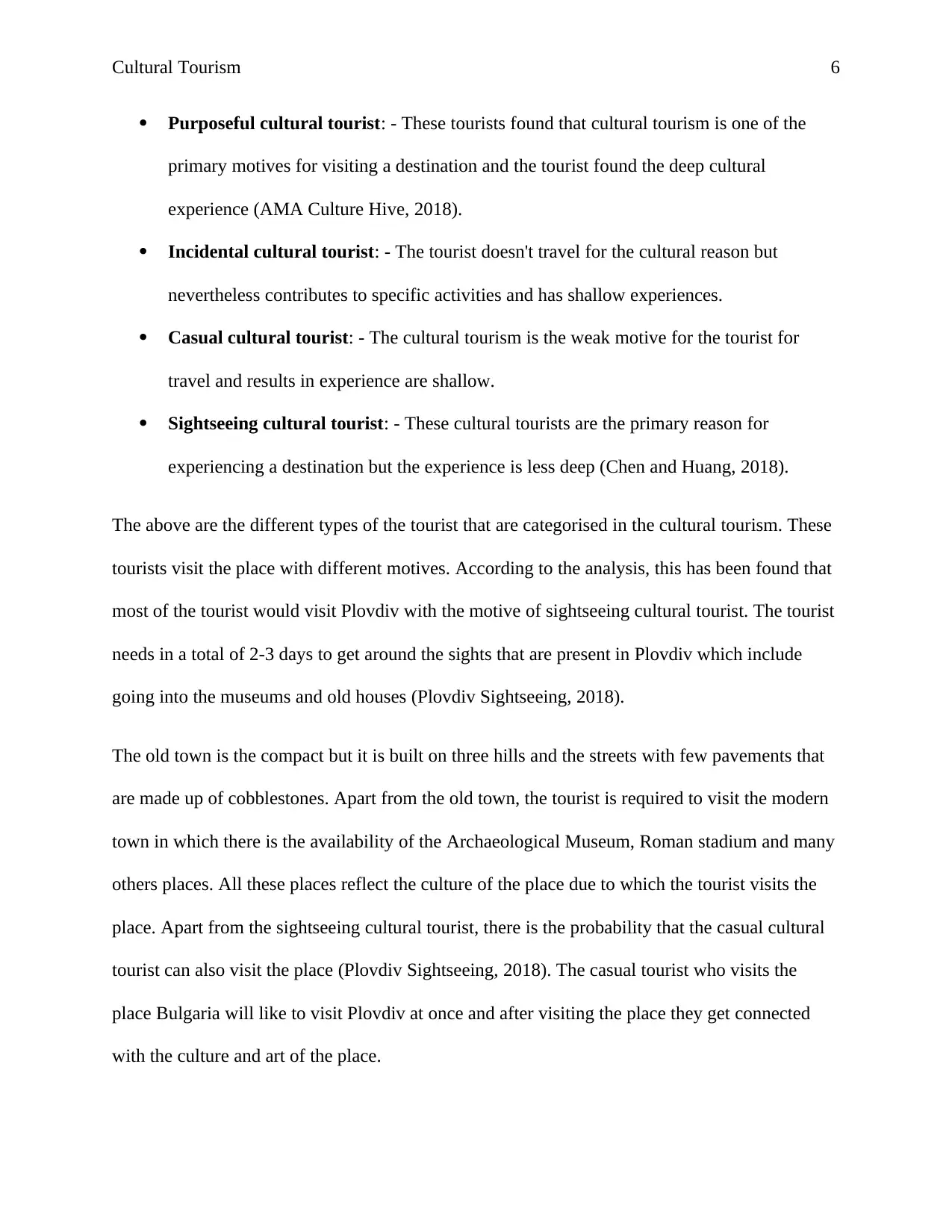
Cultural Tourism 6
Purposeful cultural tourist: - These tourists found that cultural tourism is one of the
primary motives for visiting a destination and the tourist found the deep cultural
experience (AMA Culture Hive, 2018).
Incidental cultural tourist: - The tourist doesn't travel for the cultural reason but
nevertheless contributes to specific activities and has shallow experiences.
Casual cultural tourist: - The cultural tourism is the weak motive for the tourist for
travel and results in experience are shallow.
Sightseeing cultural tourist: - These cultural tourists are the primary reason for
experiencing a destination but the experience is less deep (Chen and Huang, 2018).
The above are the different types of the tourist that are categorised in the cultural tourism. These
tourists visit the place with different motives. According to the analysis, this has been found that
most of the tourist would visit Plovdiv with the motive of sightseeing cultural tourist. The tourist
needs in a total of 2-3 days to get around the sights that are present in Plovdiv which include
going into the museums and old houses (Plovdiv Sightseeing, 2018).
The old town is the compact but it is built on three hills and the streets with few pavements that
are made up of cobblestones. Apart from the old town, the tourist is required to visit the modern
town in which there is the availability of the Archaeological Museum, Roman stadium and many
others places. All these places reflect the culture of the place due to which the tourist visits the
place. Apart from the sightseeing cultural tourist, there is the probability that the casual cultural
tourist can also visit the place (Plovdiv Sightseeing, 2018). The casual tourist who visits the
place Bulgaria will like to visit Plovdiv at once and after visiting the place they get connected
with the culture and art of the place.
Purposeful cultural tourist: - These tourists found that cultural tourism is one of the
primary motives for visiting a destination and the tourist found the deep cultural
experience (AMA Culture Hive, 2018).
Incidental cultural tourist: - The tourist doesn't travel for the cultural reason but
nevertheless contributes to specific activities and has shallow experiences.
Casual cultural tourist: - The cultural tourism is the weak motive for the tourist for
travel and results in experience are shallow.
Sightseeing cultural tourist: - These cultural tourists are the primary reason for
experiencing a destination but the experience is less deep (Chen and Huang, 2018).
The above are the different types of the tourist that are categorised in the cultural tourism. These
tourists visit the place with different motives. According to the analysis, this has been found that
most of the tourist would visit Plovdiv with the motive of sightseeing cultural tourist. The tourist
needs in a total of 2-3 days to get around the sights that are present in Plovdiv which include
going into the museums and old houses (Plovdiv Sightseeing, 2018).
The old town is the compact but it is built on three hills and the streets with few pavements that
are made up of cobblestones. Apart from the old town, the tourist is required to visit the modern
town in which there is the availability of the Archaeological Museum, Roman stadium and many
others places. All these places reflect the culture of the place due to which the tourist visits the
place. Apart from the sightseeing cultural tourist, there is the probability that the casual cultural
tourist can also visit the place (Plovdiv Sightseeing, 2018). The casual tourist who visits the
place Bulgaria will like to visit Plovdiv at once and after visiting the place they get connected
with the culture and art of the place.
Paraphrase This Document
Need a fresh take? Get an instant paraphrase of this document with our AI Paraphraser

Cultural Tourism 7
European Capital of culture 2019 Impact to the city and country
The city of Plovdiv has been declared by the European Commission the European Capital of
culture 2019. This leads to the impact on the city and the country which is discussed by
analysing the social, economic and environmental impact. Plovdiv is the first Bulgarian city
chosen that is selected for the European Capital of culture (Plovdiv 2019 European Capital of
Culture, 2018). This is one of the unique projects for Bulgaria which offers the attractive
opportunities for bringing development of the potential of the city and the new international
visibility and a perspective on Bulgarian culture as a whole. This programme includes the
activities and the events in the south central region of the country. The aim of the program is to
the diversity of the culture present within Europe.
Major impact
The country and the city will face the numerous impacts if they will host the European Capital of
Culture in 2019. This program works with the aim to bring the economic, political and social
benefits both to the cities and the countries who organizes the event. Along with this, this is the
way through which they can maintain the EU exchanges and interconnections. This impact
which is faced by the country can be positive or negative and the same has been discussed
below: -
Social factors
The social factors include the effect on the lifestyle, religion, family, cultural values and social
values. Some of these factors are discussed below: -
Quality of living
European Capital of culture 2019 Impact to the city and country
The city of Plovdiv has been declared by the European Commission the European Capital of
culture 2019. This leads to the impact on the city and the country which is discussed by
analysing the social, economic and environmental impact. Plovdiv is the first Bulgarian city
chosen that is selected for the European Capital of culture (Plovdiv 2019 European Capital of
Culture, 2018). This is one of the unique projects for Bulgaria which offers the attractive
opportunities for bringing development of the potential of the city and the new international
visibility and a perspective on Bulgarian culture as a whole. This programme includes the
activities and the events in the south central region of the country. The aim of the program is to
the diversity of the culture present within Europe.
Major impact
The country and the city will face the numerous impacts if they will host the European Capital of
Culture in 2019. This program works with the aim to bring the economic, political and social
benefits both to the cities and the countries who organizes the event. Along with this, this is the
way through which they can maintain the EU exchanges and interconnections. This impact
which is faced by the country can be positive or negative and the same has been discussed
below: -
Social factors
The social factors include the effect on the lifestyle, religion, family, cultural values and social
values. Some of these factors are discussed below: -
Quality of living
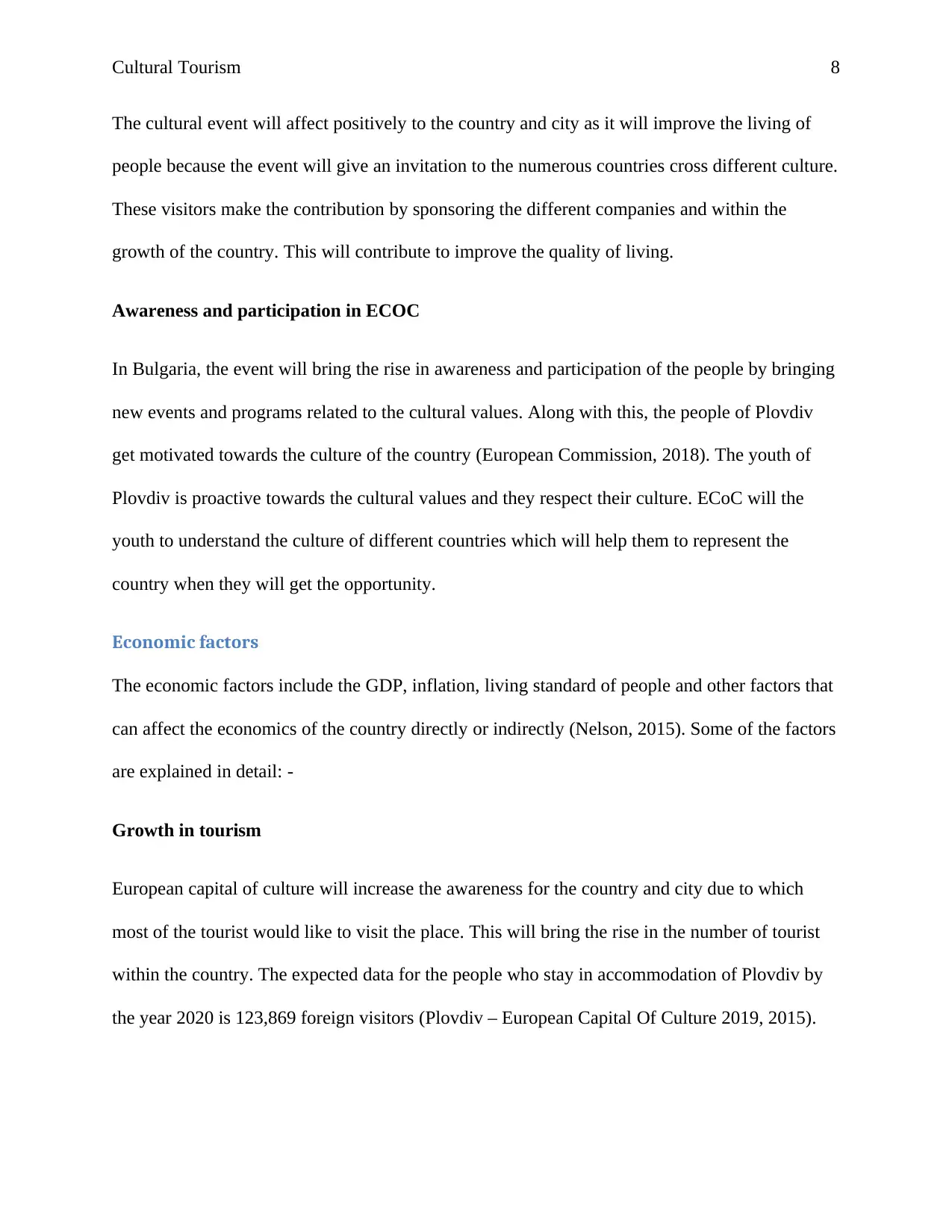
Cultural Tourism 8
The cultural event will affect positively to the country and city as it will improve the living of
people because the event will give an invitation to the numerous countries cross different culture.
These visitors make the contribution by sponsoring the different companies and within the
growth of the country. This will contribute to improve the quality of living.
Awareness and participation in ECOC
In Bulgaria, the event will bring the rise in awareness and participation of the people by bringing
new events and programs related to the cultural values. Along with this, the people of Plovdiv
get motivated towards the culture of the country (European Commission, 2018). The youth of
Plovdiv is proactive towards the cultural values and they respect their culture. ECoC will the
youth to understand the culture of different countries which will help them to represent the
country when they will get the opportunity.
Economic factors
The economic factors include the GDP, inflation, living standard of people and other factors that
can affect the economics of the country directly or indirectly (Nelson, 2015). Some of the factors
are explained in detail: -
Growth in tourism
European capital of culture will increase the awareness for the country and city due to which
most of the tourist would like to visit the place. This will bring the rise in the number of tourist
within the country. The expected data for the people who stay in accommodation of Plovdiv by
the year 2020 is 123,869 foreign visitors (Plovdiv – European Capital Of Culture 2019, 2015).
The cultural event will affect positively to the country and city as it will improve the living of
people because the event will give an invitation to the numerous countries cross different culture.
These visitors make the contribution by sponsoring the different companies and within the
growth of the country. This will contribute to improve the quality of living.
Awareness and participation in ECOC
In Bulgaria, the event will bring the rise in awareness and participation of the people by bringing
new events and programs related to the cultural values. Along with this, the people of Plovdiv
get motivated towards the culture of the country (European Commission, 2018). The youth of
Plovdiv is proactive towards the cultural values and they respect their culture. ECoC will the
youth to understand the culture of different countries which will help them to represent the
country when they will get the opportunity.
Economic factors
The economic factors include the GDP, inflation, living standard of people and other factors that
can affect the economics of the country directly or indirectly (Nelson, 2015). Some of the factors
are explained in detail: -
Growth in tourism
European capital of culture will increase the awareness for the country and city due to which
most of the tourist would like to visit the place. This will bring the rise in the number of tourist
within the country. The expected data for the people who stay in accommodation of Plovdiv by
the year 2020 is 123,869 foreign visitors (Plovdiv – European Capital Of Culture 2019, 2015).
⊘ This is a preview!⊘
Do you want full access?
Subscribe today to unlock all pages.

Trusted by 1+ million students worldwide

Cultural Tourism 9
New business opportunities
European capital of culture will bring the rise in the business opportunities for Bulgaria and
Plovdiv. The business from the different countries likes to expand their business operations in
Bulgaria due to which there will be new opportunities for the job (Plovdiv – European Capital Of
Culture 2019, 2015). This will reduce the unemployment rate of the country and the GDP of the
country will improve. The rise in GDP will further contribute to developing the countries.
Environment factors
The environmental factors include the physical environment of the country or city which consist
of the surroundings (Department for Cultural Media & Sport, 2018). European capital of culture
event can affect the negatively on the environment. Some of the factors are discussed below: -
Land use
Organizing an event include the use of land where the event will take place. This event can
exploit the productivity of the land which directly impacts the surroundings of the place.
Carbon emission
New business opportunities
European capital of culture will bring the rise in the business opportunities for Bulgaria and
Plovdiv. The business from the different countries likes to expand their business operations in
Bulgaria due to which there will be new opportunities for the job (Plovdiv – European Capital Of
Culture 2019, 2015). This will reduce the unemployment rate of the country and the GDP of the
country will improve. The rise in GDP will further contribute to developing the countries.
Environment factors
The environmental factors include the physical environment of the country or city which consist
of the surroundings (Department for Cultural Media & Sport, 2018). European capital of culture
event can affect the negatively on the environment. Some of the factors are discussed below: -
Land use
Organizing an event include the use of land where the event will take place. This event can
exploit the productivity of the land which directly impacts the surroundings of the place.
Carbon emission
Paraphrase This Document
Need a fresh take? Get an instant paraphrase of this document with our AI Paraphraser

Cultural Tourism 10
The carbon emission is one of the major factors that get affected due to the production of some
or other merchandise. This mission directly impacts the useful resources which is one of the
major impacts on the environment (European Capital of Culture, 2014).
Wastage of resources
The wastage of resources is one of the major environmental issues that are faced by the country.
Organizing such a big event include use of the resources but at the same time these resources
which include the exploitation of the infrastructure due to excessive consumption. Moreover,
there is excessive use of the resources due to poor waste streams that can ruin the experience of
the visitors (Department for Cultural Media & Sport, 2018).
Doxey’s Irridex (1975) of Plovdiv in terms of destination development
Doxey’s Irridex (1975) presented the model that provides the analysis of the effects of the
tourism development on the social relationship between the host and tourists. This model
includes the four basic stages of the tourism development along with their influence on both host
and tourists (Slavov, 2018). These stages are explained with the help of the image given below: -
The carbon emission is one of the major factors that get affected due to the production of some
or other merchandise. This mission directly impacts the useful resources which is one of the
major impacts on the environment (European Capital of Culture, 2014).
Wastage of resources
The wastage of resources is one of the major environmental issues that are faced by the country.
Organizing such a big event include use of the resources but at the same time these resources
which include the exploitation of the infrastructure due to excessive consumption. Moreover,
there is excessive use of the resources due to poor waste streams that can ruin the experience of
the visitors (Department for Cultural Media & Sport, 2018).
Doxey’s Irridex (1975) of Plovdiv in terms of destination development
Doxey’s Irridex (1975) presented the model that provides the analysis of the effects of the
tourism development on the social relationship between the host and tourists. This model
includes the four basic stages of the tourism development along with their influence on both host
and tourists (Slavov, 2018). These stages are explained with the help of the image given below: -
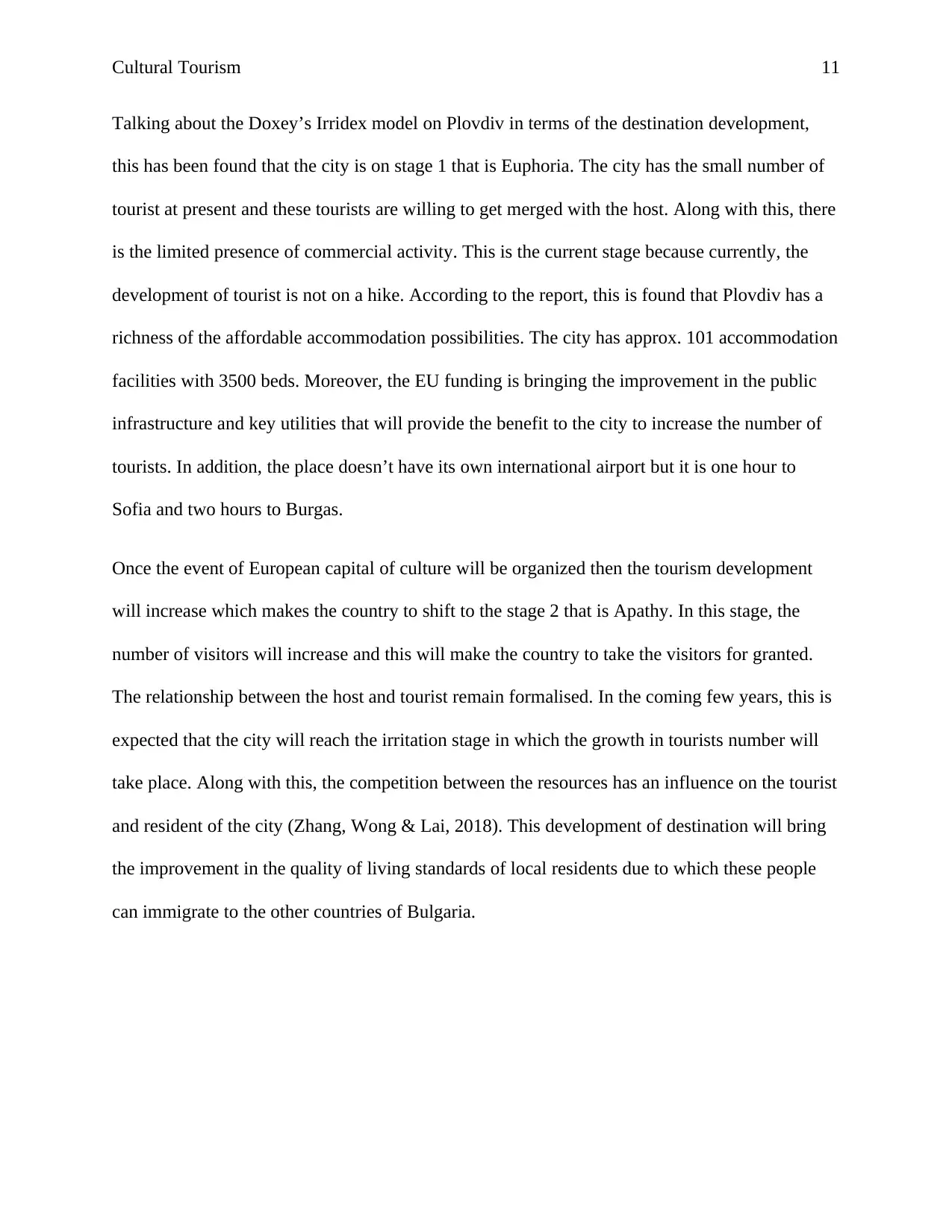
Cultural Tourism 11
Talking about the Doxey’s Irridex model on Plovdiv in terms of the destination development,
this has been found that the city is on stage 1 that is Euphoria. The city has the small number of
tourist at present and these tourists are willing to get merged with the host. Along with this, there
is the limited presence of commercial activity. This is the current stage because currently, the
development of tourist is not on a hike. According to the report, this is found that Plovdiv has a
richness of the affordable accommodation possibilities. The city has approx. 101 accommodation
facilities with 3500 beds. Moreover, the EU funding is bringing the improvement in the public
infrastructure and key utilities that will provide the benefit to the city to increase the number of
tourists. In addition, the place doesn’t have its own international airport but it is one hour to
Sofia and two hours to Burgas.
Once the event of European capital of culture will be organized then the tourism development
will increase which makes the country to shift to the stage 2 that is Apathy. In this stage, the
number of visitors will increase and this will make the country to take the visitors for granted.
The relationship between the host and tourist remain formalised. In the coming few years, this is
expected that the city will reach the irritation stage in which the growth in tourists number will
take place. Along with this, the competition between the resources has an influence on the tourist
and resident of the city (Zhang, Wong & Lai, 2018). This development of destination will bring
the improvement in the quality of living standards of local residents due to which these people
can immigrate to the other countries of Bulgaria.
Talking about the Doxey’s Irridex model on Plovdiv in terms of the destination development,
this has been found that the city is on stage 1 that is Euphoria. The city has the small number of
tourist at present and these tourists are willing to get merged with the host. Along with this, there
is the limited presence of commercial activity. This is the current stage because currently, the
development of tourist is not on a hike. According to the report, this is found that Plovdiv has a
richness of the affordable accommodation possibilities. The city has approx. 101 accommodation
facilities with 3500 beds. Moreover, the EU funding is bringing the improvement in the public
infrastructure and key utilities that will provide the benefit to the city to increase the number of
tourists. In addition, the place doesn’t have its own international airport but it is one hour to
Sofia and two hours to Burgas.
Once the event of European capital of culture will be organized then the tourism development
will increase which makes the country to shift to the stage 2 that is Apathy. In this stage, the
number of visitors will increase and this will make the country to take the visitors for granted.
The relationship between the host and tourist remain formalised. In the coming few years, this is
expected that the city will reach the irritation stage in which the growth in tourists number will
take place. Along with this, the competition between the resources has an influence on the tourist
and resident of the city (Zhang, Wong & Lai, 2018). This development of destination will bring
the improvement in the quality of living standards of local residents due to which these people
can immigrate to the other countries of Bulgaria.
⊘ This is a preview!⊘
Do you want full access?
Subscribe today to unlock all pages.

Trusted by 1+ million students worldwide
1 out of 19
Related Documents
Your All-in-One AI-Powered Toolkit for Academic Success.
+13062052269
info@desklib.com
Available 24*7 on WhatsApp / Email
![[object Object]](/_next/static/media/star-bottom.7253800d.svg)
Unlock your academic potential
Copyright © 2020–2025 A2Z Services. All Rights Reserved. Developed and managed by ZUCOL.




